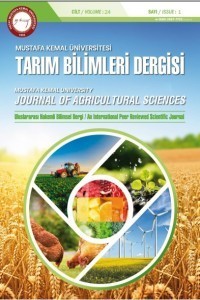Nijerya’da sebze üretiminin kırsal hanelerin gelir ve geçim kaynakları üzerindeki etkileri
Gıda güvensizliği, geçim kaynağı, yoksulluğun azaltılması, kırsal haneler, sebze yetiştiriciliği
Effects of vegetable production on income and livelihood of rural households in Nigeria
___
- Asadu AN, Ozioko RI, Dimelu MU (2018) Climate change information source and indigenous adaptation strategies of cucumber farmers in Enugu State, Nigeria. J. Agric. Exten. 22(2): 136-146.
- Ashagidigbi WM, Amos TT, Azeez F (2018) Contribution of fluted pumpkin leaf production by women to household income in the tropics. Intl J. Veg. Sci. 24(3): 205-211.
- Ayodele OO, Aboaba KO, Oladeji SO, Tolorunju ET (2021) Factors affecting productivity and intensity of market participation of leafy vegetable growers. Intl J. Veg. Sci. 27(1): 96-101.
- Fadipe AEA, Adenuga AH, Lawal A (2014) Analysis of income determinants among rural households in Kwara State, Nigeria. Trakia J. Sci. 12(4): 400–404.
- FAO (2020) On the road to the international year of fruits and vegetables 2021: Highlighting health and nutritional benefits through sustainable production and consumption of fruits and vegetables. www.fao.org/food-loss-reduction/events-and-opportunities/detail/en/c/1297167/. (Accessed on 6/7/2021).
- Heinemann E (2002) The role and limitations of producer associations. European forum for rural development cooperation. September 04-06 2002, Mont Pellier, France.
- Isitor SU, Otunaiya AO, Iyanda JO (2016) Efficiency of vegetable marketing in peri-urban areas of Ogun State, Nigeria. J. Agric. Sci. 8(3): 142–150.
- Mukaila R, Falola A, Omotesho OA (2020) Food security status: its drivers and coping strategies among vegetable farming households. Cercetări Agrono. Moldova, 53(4): 414–425.
- Mukaila R, Falola A, Egwue LO (2021a) Income diversification and drivers of rural smallholder farmers’ income in Enugu State, Nigeria. Sci. Pap. Series Manag., Econ. Engr. Agri Rural Devel. 21(3): 585-592.
- Mukaila R, Falola A, Egwue LO (2021b) The determinants of rural households’ income in Nigeria. Fiscaoeconomia 5(3): 978–989.
- Mukaila R, Obetta AE, Awoyelu FE, Chiemela CJ, Ugwu AO (2021) Marketing analysis of vegetables: The case of carrot and cucumber marketing in Enugu State, Nigeria. Turkish J. Agric.-Food Sci. Tech. 9(2): 346–351.
- Ngegba MP, Sesay M, Bangura ET (2016) The impact of vegetable farming on the livelihood of small-scale farmers in Koinadugu District Northern Sierra Leone. Glob. J. Bio-Sci. Biotech. 5(1): 42–49.
- Nzabakenga A, Feng LX, Yaqin H (2013) Agricultural income determinants among smallholder farmers: case of northern part of Burundi. Asian J. Agric. Dev. 3(11): 780–787.
- Ryś-jurek R (2019) Determinants of family farm income depending on farm size. Annals Polish Assoc. Agric. Agribus. Econ. 11(3): 401–411.
- Sabo E, Zira YD (2009) Awareness and effectiveness of vegetable technology information package by vegetable farmers in Adamawa State, Nigeria. Afr. J. Agri. Res. 4(2): 65-70.
- Schreinemachers P, Wu M, Uddin N, Ahmad S, Hanson P (2016) Farmers' training in off-season vegetables: Effects on income and pesticide use in Bangladesh. Food Policy, 61: 132–140.
- Timsina. KP, Shivakoti GP (2018) Vegetable production and marketing : practice and perception of vegetable seed producers and fresh growers in Nepal. Agri. and Food Sec. 7(11): 1–9.
- Tsiboe F, Asravor J, Osei E (2019) Vegetable production technical efficiency and technology gaps in Ghana. Afr. J. Agri. and Resour. Econs. 14(4): 255–278.
- Yayın Aralığı: Yılda 3 Sayı
- Başlangıç: 1996
- Yayıncı: Hatay Mustafa Kemal Üniversitesi
Nijerya’da sebze üretiminin kırsal hanelerin gelir ve geçim kaynakları üzerindeki etkileri
Ridwan MUKAİLA, Abraham FALOLA, Sheu-usman Oladipo AKANBİ, Lynda EGWUE, Angela OBETTA, Tochukwu Linda ONAH
Aysel Zübeyde ERDEVİL, Ali ERKILIÇ
Pancar fidelerinin büyümesi ve kalitesine toprak biyostimulant uygulamasının etkisi
Marcelle BETTONİ, Duelen Carolay CASTRO CABRAL, Tefide KIZILDENİZ
Yerel fasulye (Phaseolus vulgaris L.) genotiplerinin agro-morfolojik karakterizasyonu
Cin mısırının (Zea mays everta Sturt.) bazı kalite özelliklerine sulamanın etkisi
Cem Tufan AKÇALI, Cenk Burak ŞAHİN
İbrahim ERTEKİN, Şaban YILMAZ, Ersin CAN
Senay MURAT DOĞRU, Hayati KAR, Mehtap ÖZBAKIR ÖZER, Nur KOBAL BEKAR
Bazı yabancı badem çeşitlerinin Gaziantep ekolojisindeki verim ve meyve özellikleri
Neriman ERCAN, Ebru KARNEZ, Benian PINAR AKTEPE, Yesim AYSAN
